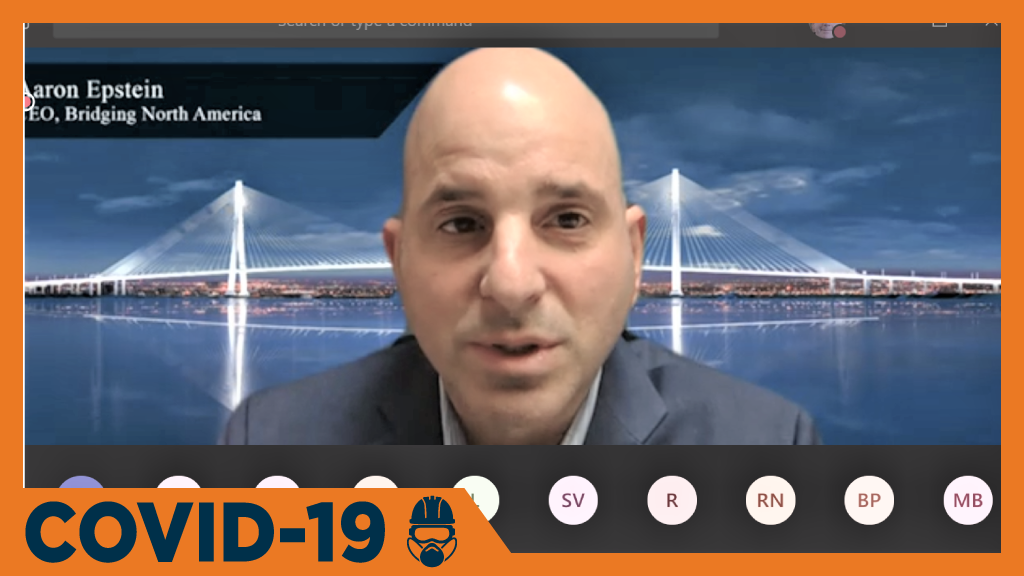Productivity losses due to COVID-19 have affected work on the Gordie Howe International Bridge but proponents say the completion target of 2024 has not changed.
Executives with the Windsor-Detroit Bridge Authority (WDBA), the owner, and construction consortium Bridging North America (BNA) gave their first comprehensive update on the project since the start of the pandemic and revealed a list of nine recipients of $100,000 in total grants as part of the project’s Community Benefits Plan.
Work has continued on both sides of the border during the pandemic with the project considered essential in both Michigan and Ontario.
“It’s been almost three months dealing with COVID-19 and we are working to understand the impacts and how can we mitigate those impacts,” said Bryce Phillips, CEO of the WDBA during the June 10 event. “The reason why we are still showing the end of 2024 is because that is still four years away and there is still a lot of opportunity over the next four years to mitigate against what’s happened with COVID-19.”
Phillips was joined at the media conference by BNA CEO Aaron Epstein. The WDBA is working closely with BNA to determine how the work schedule might be affected but it’s very difficult to predict the impacts of COVID-19, Phillips commented.
“It will be a challenge, no doubt about it,” he said.
Full safety protocols have been implemented including physical distancing, masks for all workers, daily screening and suspension of cross-boarder travel for non-essential workers, Phillips said.
“There have been spot checks by the Ministry of Labour a number of times and they always come out two thumbs up dealing with the safety protocols,” he reported. “There is a lot of stuff being learned by a lot of people, but Aaron and his team deserve a lot of credit to ensure construction proceeds safely for all those involved.”
The fixed-priced public-private partnership contract on the project was awarded to BNA in 2018. It’s valued at $5.7 billion and includes a design-build phase and an operation, maintenance and rehabilitation phase.
BNA team members include ACS Infrastructure Canada, Dragados Canada Inc., Fluor Canada, Aecon, Aecom, RBC Dominion Securities, Carlos Fernandez Casado and FHECOR Ingenieros Consultores, S.A., Moriyama & Teshima and Smith-Miller+Hawkinson Architects.
Construction is proceeding simultaneously on all four project components – the bridge, the Canadian and U.S. ports of entry, and the Michigan Interchange.
Outlining work done recently and plans for the spring and summer, Epstein noted, “The last few months have been very challenging for everyone around the world and it’s no different for those working on the Gordie Howe Bridge.”
On the Canadian side, a four-kilometre perimeter access road around the Canadian port of entry has been constructed and Hydro One transmission lines and cables have been installed and are now being tested.
Wick drain installations are continuing to enable moisture to escape from the wet soil, with 103,000 wick drains recently installed to bring the total to 150,000.
Crews have also placed 650,000 metric tonnes of permanent grade raise.
Three bridges have been demolished on the U.S. side and wick installation continues there as well, Epstein reported.
Bridge footing has been completed and tower footings are now being installed.
“They will be seen above ground later this year,” he said.
The final design of the bridge itself is almost completed, Epstein said. It’s now being reviewed by subject-matter experts from around the world.
Among the nine projects sharing the community benefits allocations announced, most were for community groups’ events and programming. The largest of three infrastructure grants is $20,000 going towards a Canadian project, the Sandwich Underground Railroad Freedom Museum. The Sandwich First Baptist Church will construct the structure within a modified shipping container located in the Sandwich community in Windsor.
Lana Talbot, cultural director of the Sandwich First Baptist Church, was on hand to discuss the grant and noted she was a descendent of escaped slaves who arrived in Canada via the Underground Railway.
“We would like to thank the community investment initiative and Bridging North America for even considering us,” she said. “The joining together of two nations in being able to bridge the gap that sometimes exists is just a wonderful thing to be able to do.
“Our story has never been told. We are now ready to tell our story.”
Follow the author on Twitter @DonWall_DCN.











Recent Comments
comments for this post are closed